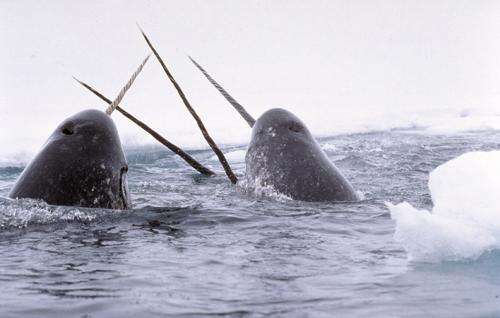September 23, 2014 weblog
Narwhal tusk length linked to testes mass suggesting its purpose is for attracting females

(Phys.org) —A team of researchers studying narwhal and beluga whales in their native Arctic ecosystem has found what appears to be a correlation between testes mass and tusk length in narwhals—suggesting the horn-like appendage exists as a means for males to attract females. In their paper published in Marine Mammal Science, the team describes how they obtained narwhal anatomy measurements and why they believe the tusk serves mostly as a fertility draw.
The narwhal tusk has inspired a lot of theories regarding its reason for existing (for use as a weapon, water tester or even as a means of conjuring magic) but thus far, most remain just that because of the lack of study done on the whales in their native environment. In this latest effort the research team set out to learn more about both narwhal and beluga whales, specifically their mating practices, because they would like to better understand how both whales might react to global warming.
To learn more about the whales, the researchers obtained data collected between the years 1997 to 2008 by Inuits who are allowed to hunt the whales. The data consisted mainly of measurements, which included the reproductive tracts of every whale caught, and the length and girth of narwhal tusks. In studying the measurements, the team found what appears to be a very clear correlation between testes mass in narwhals, and tusk length—the more massive the testes, the longer the tusk. This, the team claims, indicates that the tusk is used by the males to attract females, or conversely, it's a sign females use to determine which males will likely be the most fertile.
The team also reports that they found no significant differences between narwhal and beluga reproductive tract length for males or females, though the beluga whale had much larger testes relative to body size than narwhals, suggesting that beluga males have more female sexual partners.
Thus far the research group doesn't appear to have found any evidence to suggest how either whale species might respond to global warming (which will mean warming sea temperatures), but they do conclude that because of the different mating strategies used by the whales, they likely will respond differently to climate change.
More information: Mating ecology of beluga (Delphinapterus leucas) and narwhal (Monodon monoceros) as estimated by reproductive tract metrics, Marine Mammal Science, 2014. DOI: 10.1111/mms.12165
Abstract
Narwhal and beluga whales are important species to Arctic ecosystems, including subsistence hunting by Inuit, and little is understood about their mating ecology. Reproductive tract metrics vary across species in relation to mating strategy, and have been used to infer mating ecology. Reproductive tracts from beluga and narwhal were collected between 1997 and 2008 from five beluga stocks and two narwhal stocks across the Canadian Arctic. Tract length for males and females, relative testes mass for males, and tusk length for male narwhal were measured. We assessed variation relative to species, body size, stock, maturity, and season. Significant variation was found in testes mass across month and stock for beluga, and no significant difference between stock or date of harvest for narwhal. Beluga had significantly larger testes relative to body size than narwhal, suggesting they were more promiscuous than narwhal. A significant relationship was found between narwhal tusk length and testes mass, indicating the tusk may be important in female mate choice. No significant differences were found between narwhal and beluga reproductive tract length for males or females. The mating systems suggested for narwhal and belugas by our results mean the two species may respond differently to climate change.
Journal information: Marine Mammal Science
© 2014 Phys.org





















